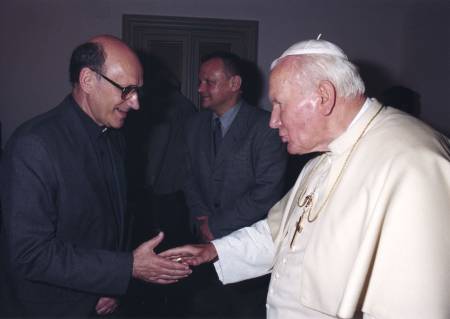
The Templeton Foundation today announced that the Polish mathematical physicist and former priest Michael Heller will receive the 2008 Templeton Prize. Heller, whose more than 40 year-long career has encompassed research in theology, philosophy, mathematics and cosmology, intends to use the £820,000 prize to found an inter-university institute in Poland that will investigate questions in science, theology and philosophy.
The Templeton Prize, which was established in 1972 by the philanthropist Sir John Templeton, is awarded annually to a living recipient for “progress toward research or discoveries about spiritual realities”. According to the Templeton Foundation, the award is intended to encourage the concept that resources and manpower are needed to accelerate progress in spiritual discoveries, which means in practice that the award often goes to a scientist. Physicists have been particularly successful in recent years: former laureates include John Barrow (2006), Charles Townes (2005), George Ellis (2004), John Polkinghorne (2002), Freeman Dyson (2000) and Paul Davies (1995).
It seems obvious that science just reads the mind of God Michael Heller
Heller continues this trend. Although only holding degrees in theology and philosophy, he also unofficially studied physics while at the Catholic University of Lublin in Poland, which did not have the right to grant degrees in physics. Since then Heller has conducted research in several areas of cosmology and mathematics, and is currently working on a new branch of mathematics known as non-commutative geometry.
“The standard model of cosmology treats space as a differential manifold, but this concept breaks down at singularities, so understanding the geometry of the big bang is a major issue for cosmologists,” Heller told physicsworld.com. “Non-commutative geometry — which is totally non-local in character so the idea of points, for example, is totally meaningless — can cope with singularities.” According to Heller, the theory also has the potential to unify the areas of gravity, quantum mechanics, thermodynamics and probability.
Heller, 72, is also a devout Catholic, and indeed he originally trained as a priest. This might seem like an unusual combination, but attitudes in Soviet-controlled Poland were supportive of religious scientists. “The communist regime was atheist, but the Poles were rebellious against that and unofficially I was welcomed by Polish physicists,” he says. And, in common with other Templeton Prize-winning scientists, Heller sees no incompatibility between religion and science.
“From the point of view of theology I see no contradiction because it seems obvious that science just reads the mind of God,” he says. Looking at it from the point of view of science, however, Heller admits that the situation is less clear cut. “It depends on your concept of rationality,” he explains. “If you think that the limits of rationality coincide with the limits of the scientific method, then science and religion are incompatible.” Heller, however, believes that rationality extends beyond what can be discovered with science — in other words that there may be aspects of the universe that are beyond the reach of science.
These views, together with his strong background in both science and religion, are undoubtedly part of the reason why Heller was chosen as this year’s winner. As the author of some 30 books, including The New Physics and a New Theology and Creative Tension: Essays on Science and Religion, he is, in his own words, a “bridging person” who can facilitate a dialogue between the two communities. Heller intends to use the prize money to do just that by setting up an inter-university institute to investigate questions in science, philosophy and theology. Dubbed the “Copernicus Centre”, the new institute will be affiliated with the Jagiellonian University and the Pontifical Academy of Theology in Cracow. And, of course, he will be continuing his physics research.



